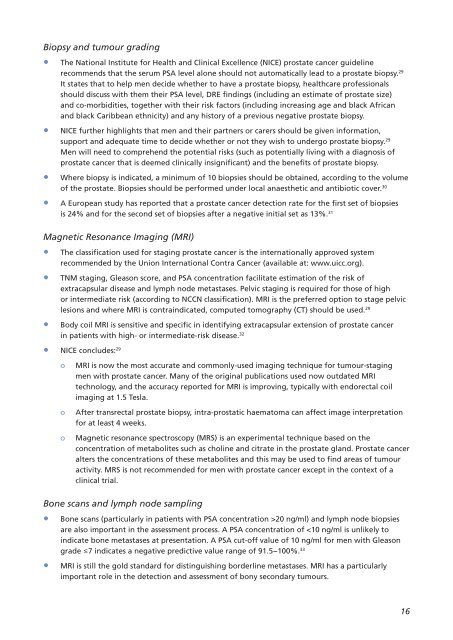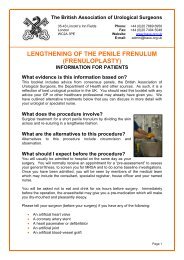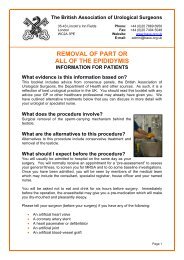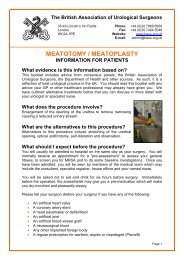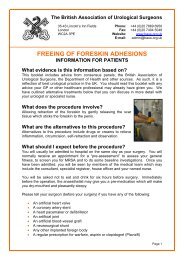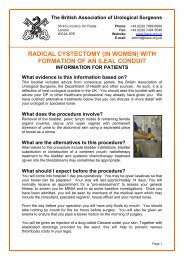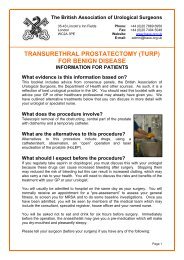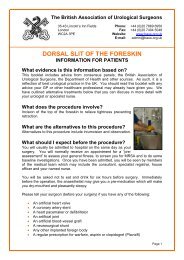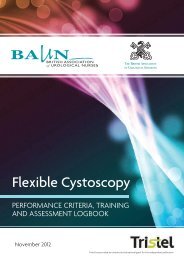MDT (multi-disciplinary team) guidance for managing prostate cancer
MDT (multi-disciplinary team) guidance for managing prostate cancer
MDT (multi-disciplinary team) guidance for managing prostate cancer
Create successful ePaper yourself
Turn your PDF publications into a flip-book with our unique Google optimized e-Paper software.
Biopsy and tumour grading<br />
• The National Institute <strong>for</strong> Health and Clinical Excellence (NICE) <strong>prostate</strong> <strong>cancer</strong> guideline<br />
recommends that the serum PSA level alone should not automatically lead to a <strong>prostate</strong> biopsy. 29<br />
It states that to help men decide whether to have a <strong>prostate</strong> biopsy, healthcare professionals<br />
should discuss with them their PSA level, DRE findings (including an estimate of <strong>prostate</strong> size)<br />
and co-morbidities, together with their risk factors (including increasing age and black African<br />
and black Caribbean ethnicity) and any history of a previous negative <strong>prostate</strong> biopsy.<br />
• NICE further highlights that men and their partners or carers should be given in<strong>for</strong>mation,<br />
support and adequate time to decide whether or not they wish to undergo <strong>prostate</strong> biopsy. 29<br />
Men will need to comprehend the potential risks (such as potentially living with a diagnosis of<br />
<strong>prostate</strong> <strong>cancer</strong> that is deemed clinically insignificant) and the benefits of <strong>prostate</strong> biopsy.<br />
• Where biopsy is indicated, a minimum of 10 biopsies should be obtained, according to the volume<br />
of the <strong>prostate</strong>. Biopsies should be per<strong>for</strong>med under local anaesthetic and antibiotic cover. 30<br />
• A European study has reported that a <strong>prostate</strong> <strong>cancer</strong> detection rate <strong>for</strong> the first set of biopsies<br />
is 24% and <strong>for</strong> the second set of biopsies after a negative initial set as 13%. 31<br />
Magnetic Resonance Imaging (MRI)<br />
• The classification used <strong>for</strong> staging <strong>prostate</strong> <strong>cancer</strong> is the internationally approved system<br />
recommended by the Union International Contra Cancer (available at: www.uicc.org).<br />
• TNM staging, Gleason score, and PSA concentration facilitate estimation of the risk of<br />
extracapsular disease and lymph node metastases. Pelvic staging is required <strong>for</strong> those of high<br />
or intermediate risk (according to NCCN classification). MRI is the preferred option to stage pelvic<br />
lesions and where MRI is contraindicated, computed tomography (CT) should be used. 29<br />
• Body coil MRI is sensitive and specific in identifying extracapsular extension of <strong>prostate</strong> <strong>cancer</strong><br />
in patients with high- or intermediate-risk disease. 32<br />
• NICE concludes: 29<br />
o MRI is now the most accurate and commonly-used imaging technique <strong>for</strong> tumour-staging<br />
men with <strong>prostate</strong> <strong>cancer</strong>. Many of the original publications used now outdated MRI<br />
technology, and the accuracy reported <strong>for</strong> MRI is improving, typically with endorectal coil<br />
imaging at 1.5 Tesla.<br />
o After transrectal <strong>prostate</strong> biopsy, intra-prostatic haematoma can affect image interpretation<br />
<strong>for</strong> at least 4 weeks.<br />
o Magnetic resonance spectroscopy (MRS) is an experimental technique based on the<br />
concentration of metabolites such as choline and citrate in the <strong>prostate</strong> gland. Prostate <strong>cancer</strong><br />
alters the concentrations of these metabolites and this may be used to find areas of tumour<br />
activity. MRS is not recommended <strong>for</strong> men with <strong>prostate</strong> <strong>cancer</strong> except in the context of a<br />
clinical trial.<br />
Bone scans and lymph node sampling<br />
• Bone scans (particularly in patients with PSA concentration >20 ng/ml) and lymph node biopsies<br />
are also important in the assessment process. A PSA concentration of


